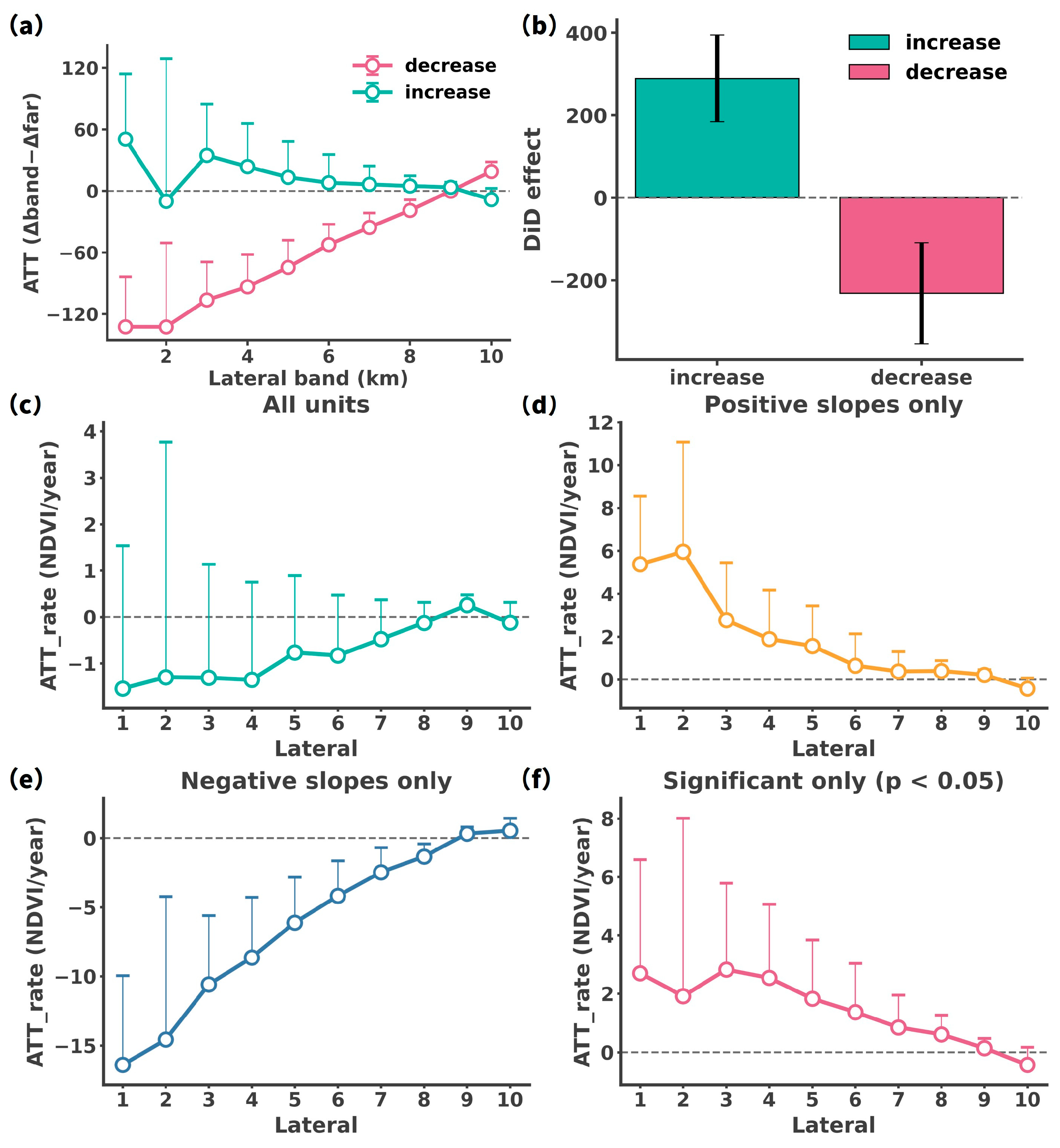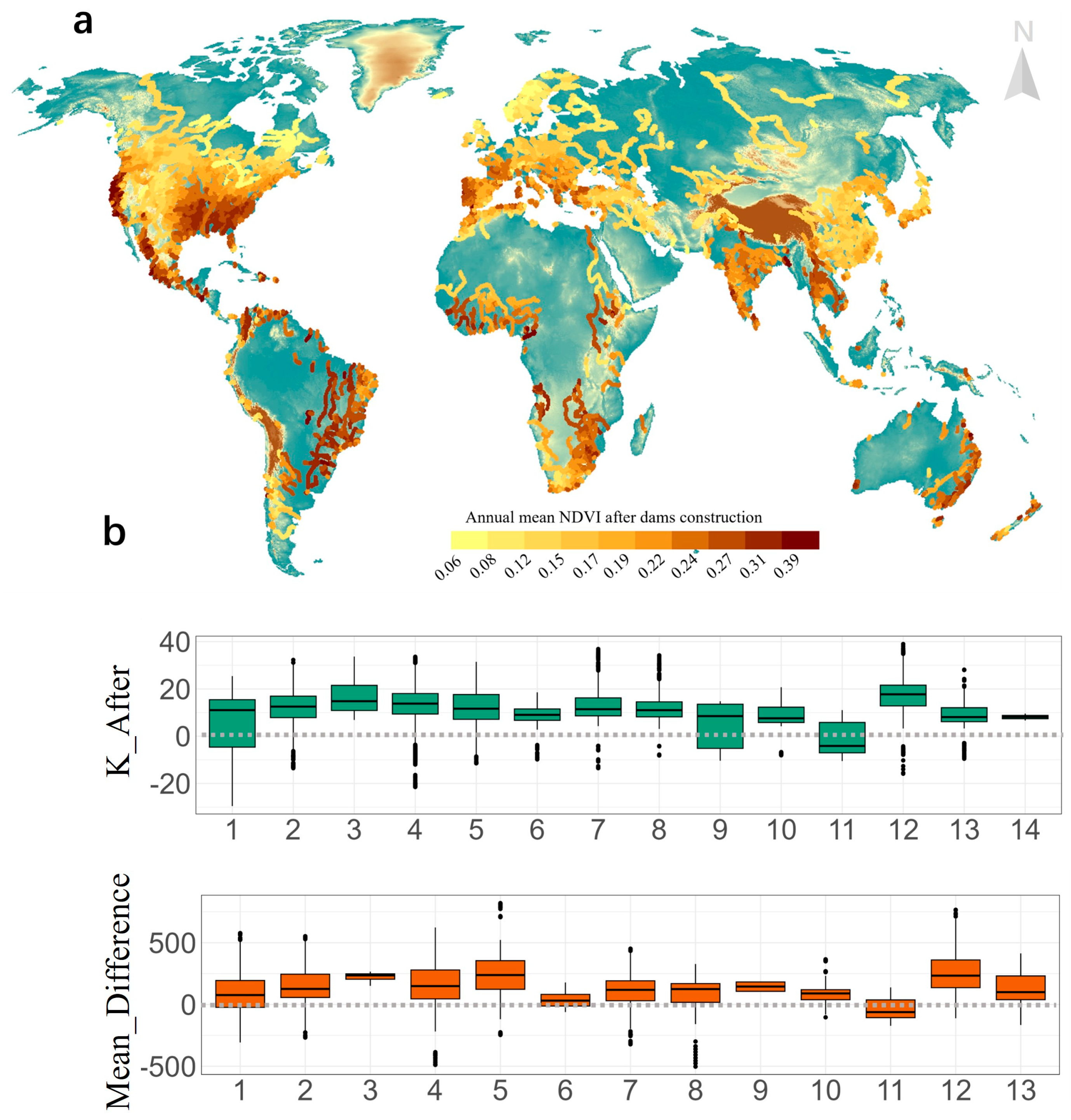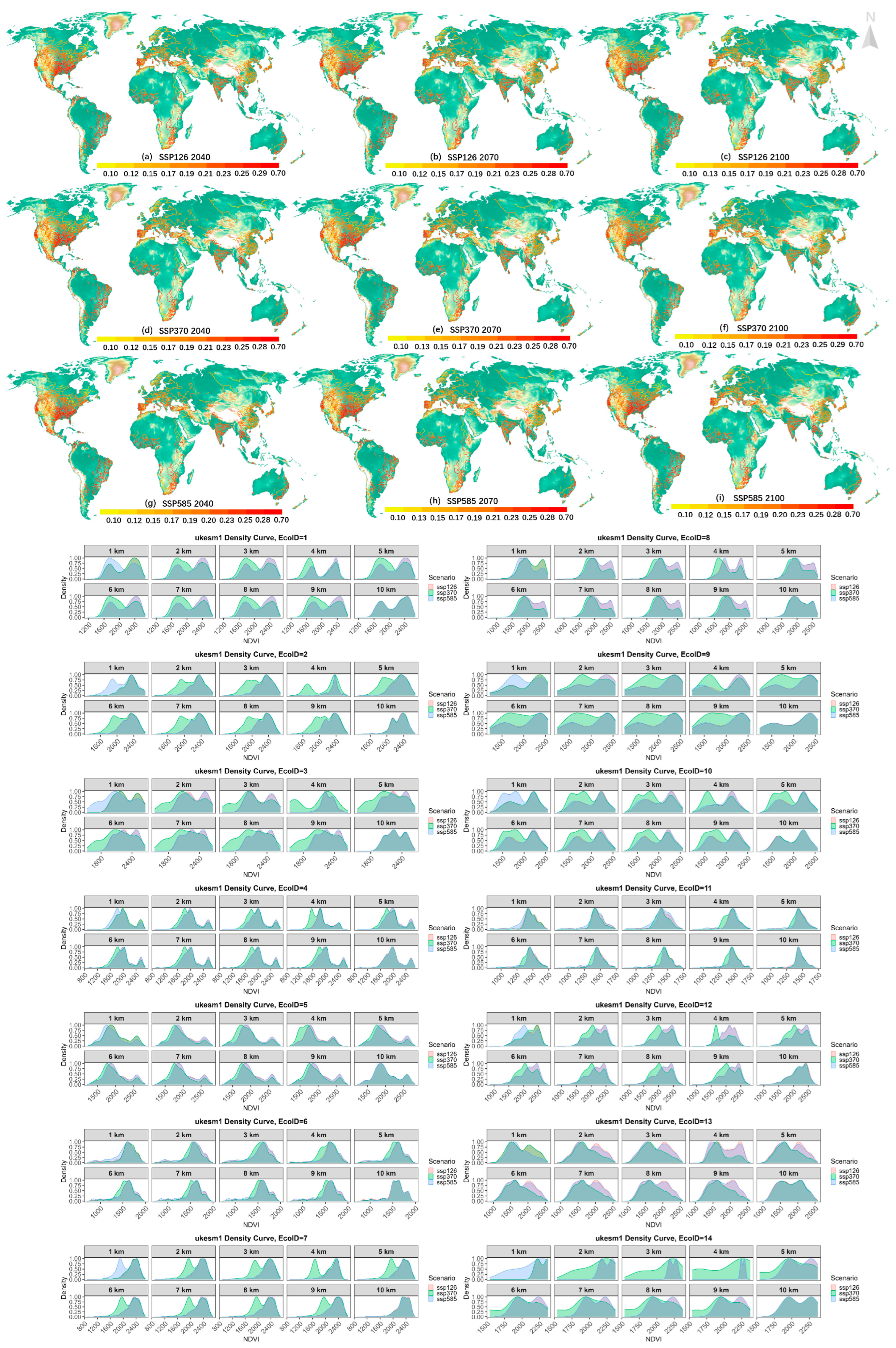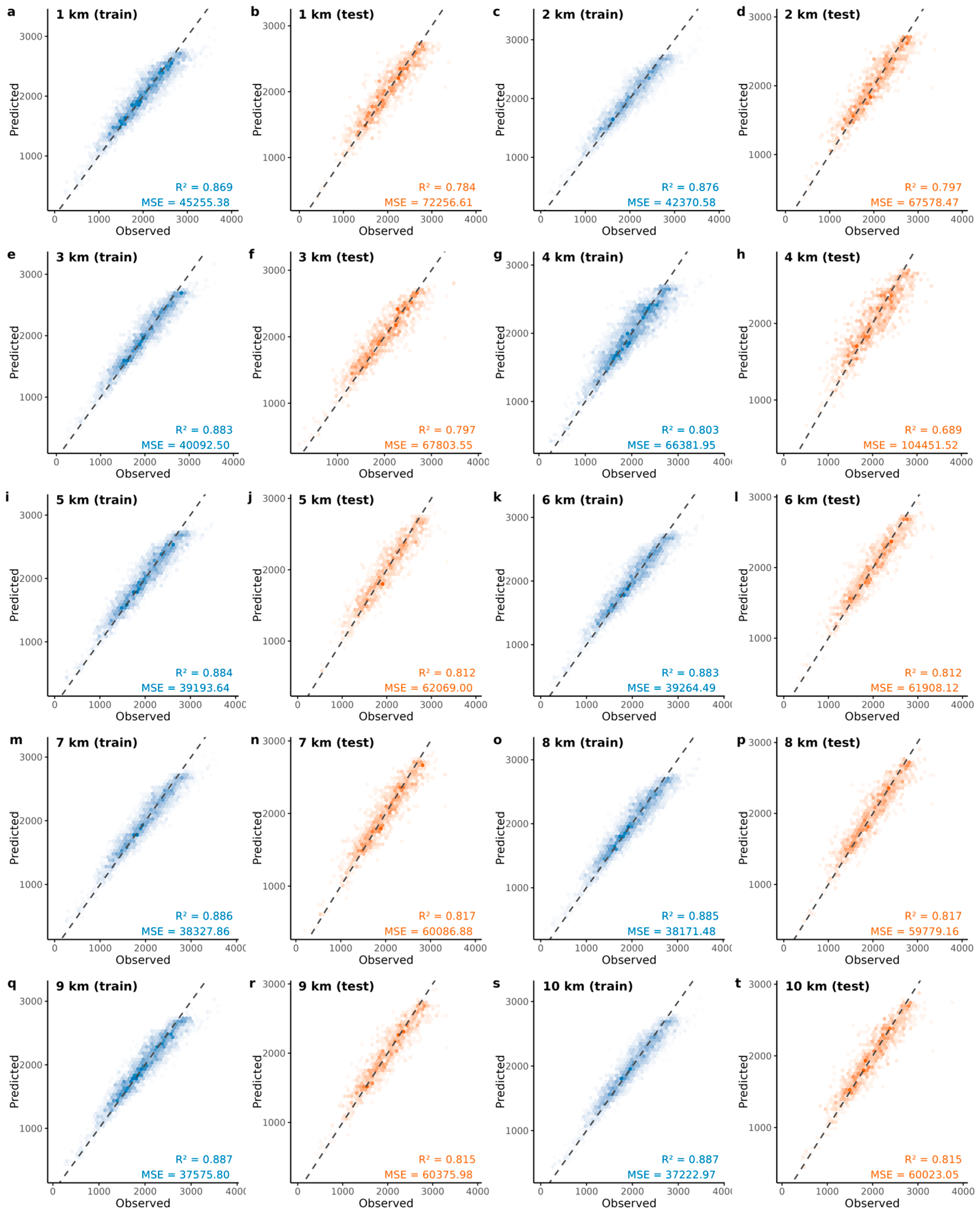Satellite Remote Sensing Reveals Global Dam Impacts on Riparian Vegetation Dynamics Under Future Climate Scenarios
Abstract
1. Introduction
2. Materials and Methods
2.1. Data
2.2. Methods
2.2.1. Study Area
2.2.2. Time Series Analysis
- ΔNDVI(D, i) represents the change in NDVI for the i-th buffer zone within distance D.
- NDVIpost(D, i) represents the NDVI value of the i-th buffer zone after dam construction at distance D.
- NDVIpre(D, i) represents the NDVI value of the i-th buffer zone before dam construction at distance D.
2.2.3. Linear Regression
2.2.4. Gradient Boosting Regression Model GBRM
2.2.5. Counterfactual Evaluation of Dam Impacts on Riparian NDVI (ATT, DiD)
3. Results
4. Discussion
Supplementary Materials
Author Contributions
Funding
Data Availability Statement
Conflicts of Interest
Appendix A

References
- Zarfl, C.; Lumsdon, A.E.; Berlekamp, J.; Tydecks, L.; Tockner, K. A global boom in hydropower dam construction. Aquat. Sci. 2015, 77, 161–170. [Google Scholar] [CrossRef]
- Chen, W.; Olden, J.D. Designing flows to resolve human and environmental water needs in a dam-regulated river. Nat. Commun. 2017, 8, 2158. [Google Scholar] [CrossRef] [PubMed]
- Tealdi, S.; Camporeale, C.; Ridolfi, L. Modeling the impact of river damming on riparian vegetation. J. Hydrol. 2011, 396, 302–312. [Google Scholar] [CrossRef]
- Kellogg, C.H.; Zhou, X. Impact of the construction of a large dam on riparian vegetation cover at different elevation zones as observed from remotely sensed data. Int. J. Appl. Earth Obs. Geoinf. 2014, 32, 19–34. [Google Scholar] [CrossRef]
- Botelho, A.; Ferreira, P.; Lima, F.; Pinto, L.M.C.; Sousa, S. Assessment of the environmental impacts associated with hydropower. Renew. Sustain. Energy Rev. 2017, 70, 896–904. [Google Scholar] [CrossRef]
- Al-Munqedhi, B.M.; El-Sheikh, M.A.; Alfarhan, A.H.; Alkahtani, A.M.; Arif, I.A.; Rajagopal, R.; Alharthi, S.T. Climate change and hydrological regime in arid lands: Impacts of dams on the plant diversity, vegetation structure and soil in Saudi Arabia. Saudi J. Biol. Sci. 2022, 29, 3194–3206. [Google Scholar] [CrossRef]
- Timpe, K.; Kaplan, D. The changing hydrology of a dammed Amazon. Sci. Adv. 2017, 3, e1700611. [Google Scholar] [CrossRef] [PubMed]
- Grill, G.; Lehner, B.; Thieme, M.; Geenen, B.; Tickner, D.; Antonelli, F.; Babu, S.; Borrelli, P.; Cheng, L.; Crochetiere, H.; et al. Mapping the world’s free-flowing rivers. Nature 2019, 569, 215–221. [Google Scholar] [CrossRef]
- Richter, B.D.; Lamsal, G.; Marston, L.; Dhakal, S.; Sangha, L.S.; Rushforth, R.R.; Wei, D.; Ruddell, B.L.; Davis, K.F.; Hernandez-Cruz, A.; et al. New water accounting reveals why the Colorado River no longer reaches the sea. Commun. Earth Environ. 2024, 5, 134. [Google Scholar] [CrossRef]
- Ezcurra, E.; Barrios, E.; Ezcurra, P.; Ezcurra, A.; Vanderplank, S.; Vidal, O.; Villanueva-Almanza, L.; Aburto-Oropeza, O. A natural experiment reveals the impact of hydroelectric dams on the estuaries of tropical rivers. Sci. Adv. 2019, 5, eaau9875. [Google Scholar] [CrossRef]
- Yi, Y.J.; Zhou, Y.; Song, J.; Zhang, S.; Cai, Y.; Yang, W.; Yang, Z. The effects of cascade dam construction and operation on riparian vegetation. Adv. Water Resour. 2019, 131, 10326. [Google Scholar] [CrossRef]
- Gonçalves-Souza, D.; Vilela, B.; Phalan, B.; Dobrovolski, R. The role of protected areas in maintaining natural vegetation in Brazil. Sci. Adv. 2021, 7, eabh2932. [Google Scholar] [CrossRef]
- Sankey, J.B.; Ralston, B.E.; Grams, P.E.; Schmidt, J.C.; Cagney, L.E. Riparian vegetation, Colorado River, and climate: Five decades of spatiotemporal dynamics in the Grand Canyon with river regulation. J. Geophys. Res. Biogeosciences 2015, 120, 1532–1547. [Google Scholar] [CrossRef]
- Isbell, F.; Craven, D.; Connolly, J.; Loreau, M.; Schmid, B.; Beierkuhnlein, C.; Bezemer, T.M.; Bonin, C.; Bruelheide, H.; de Luca, E.; et al. Biodiversity increases the resistance of ecosystem productivity to climate extremes. Nature 2015, 526, 574–577. [Google Scholar] [CrossRef]
- Fischer, S.; Greet, J.; Walsh, C.J.; Catford, J.A. Flood disturbance affects morphology and reproduction of woody riparian plants. Sci. Rep. 2021, 11, 16477. [Google Scholar] [CrossRef] [PubMed]
- Yu, S.-Y.; Li, W.-J.; Zhou, L.; Yu, X.; Zhang, Q.; Shen, Z. Human disturbances dominated the unprecedentedly high frequency of Yellow River flood over the last millennium. Sci. Adv. 2023, 9, eadf8576. [Google Scholar] [CrossRef] [PubMed]
- Hossain, F. Empirical Relationship between Large Dams and the Alteration in Extreme Precipitation. Nat. Hazards Rev. 2010, 11, 97–101. [Google Scholar] [CrossRef]
- Stahly, S.; Franca, M.J.; Robinson, C.T.; Schleiss, A.J. Sediment replenishment combined with an artificial flood improves river habitats downstream of a dam. Sci. Rep. 2019, 9, 5176. [Google Scholar] [CrossRef] [PubMed]
- Liu, Y.; Lu, H.; Tian, P.; Qiu, L. Evaluating the effects of dams and meteorological variables on riparian vegetation NDVI in the Tibetan Plateau. Sci. Total Environ. 2022, 831, 154933. [Google Scholar] [CrossRef]
- He, L.; Liu, Y.-L.; Tang, Z.-J.; Sun, T.; Yan, Y.-M.; Xia, Y.-F.; Feng, H.-S.; Ye, W. Intensified excessive wastage of key raw metals with expansion of global wind and solar photovoltaic energy development. Resour. Conserv. Recycl. 2025, 215, 108127. [Google Scholar] [CrossRef]
- Aguiar, F.C.; Martins, M.J.; Silva, P.C.; Fernandes, M.R. Riverscapes downstream of hydropower dams: Effects of altered flows and historical land-use change. Landsc. Urban. Plan. 2016, 153, 83–98. [Google Scholar] [CrossRef]
- Ouyang, W.; Skidmore, A.K.; Hao, F.H.; Toxopeus, A.G.; Abkar, A. Accumulated effects on landscape pattern by hydroelectric cascade exploitation in the Yellow River basin from 1977 to 2006. Landsc. Urban Plan 2009, 93, 163–171. [Google Scholar] [CrossRef]
- Wang, S.; Li, H.; Wei, X.; Zhu, N.; Sun, P.; Xia, L.; Tang, C.; Han, Q.; Zhang, G.; Liu, C.; et al. Dam Construction as an Important Anthropogenic Activity Disturbing Soil Organic Carbon in Affected Watersheds. Environ. Sci. Technol. 2020, 54, 7932–7941. [Google Scholar] [CrossRef]
- Luan, J.; Zhang, Y.; Li, X.; Ma, N.; Naeem, S.; Xu, Z.; Miao, P.; Wang, R. Disentangling streamflow impacts of check dams from vegetation changes. J. Hydrol. 2024, 638, 131477. [Google Scholar] [CrossRef]
- Tonkin, J.D.; Merritt, D.M.; Olden, J.D.; Reynolds, L.V.; Lytle, D.A. Flow regime alteration degrades ecological networks in riparian ecosystems. Nat. Ecol. Evol. 2018, 2, 86–93. [Google Scholar] [CrossRef] [PubMed]
- Gumiero, B.; Rinaldi, M.; Belletti, B.; Lenzi, D.; Puppi, G. Riparian vegetation as indicator of channel adjustments and environmental conditions: The case of the Panaro River (Northern Italy). Aquat. Sci. 2015, 77, 563–582. [Google Scholar] [CrossRef]
- Cuo, L.; Lettenmaier, D.P.; Alberti, M.; Richey, J.E. Effects of a century of land cover and climate change on the hydrology of the Puget Sound basin. Hydrol. Process 2009, 23, 907–933. [Google Scholar] [CrossRef]
- Pettorelli, N.; Vik, J.O.; Mysterud, A.; Gaillard, J.-M.; Tucker, C.J.; Stenseth, N.C. Using the satellite-derived NDVI to assess ecological responses to environmental change. Trends Ecol. Evol. 2005, 20, 503–510. [Google Scholar] [CrossRef]
- Zhang, Y.; Wang, X.; Li, C.; Cai, Y.; Yang, Z.; Yi, Y. NDVI dynamics under changing meteorological factors in a shallow lake in future metropolitan, semiarid area in North China. Sci. Rep. 2018, 8, 15971. [Google Scholar] [CrossRef]
- Wen, Z.; Wu, S.; Chen, J.; Lü, M. NDVI indicated long-term interannual changes in vegetation activities and their responses to climatic and anthropogenic factors in the Three Gorges Reservoir Region, China. Sci. Total Environ. 2017, 574, 947–959. [Google Scholar] [CrossRef]
- Evans, J.E.; Huxley, J.M.; Vincent, R.K. Upstream channel changes following dam construction and removal using a GIS/remote sensing approach. J. Am. Water Resour. Assoc. 2007, 43, 683–697. [Google Scholar] [CrossRef]
- Fu, B.; Li, Y.; Wang, Y.; Campbell, A.; Zhang, B.; Yin, S.; Zhu, H.; Xing, Z.; Jin, X. Evaluation of riparian condition of Songhua River by integration of remote sensing and field measurements. Sci. Rep. 2017, 7, 2565. [Google Scholar] [CrossRef] [PubMed]
- Maselli, F. Monitoring forest conditions in a protected Mediterranean coastal area by the analysis of multiyear NDVI data. Remote Sens. Environ. 2004, 89, 423–433. [Google Scholar] [CrossRef]
- Shen, B.; Fang, S.; Gang, L. Vegetation Coverage Changes and Their Response to Meteorological Variables from 2000 to 2009 in Naqu, Tibet, China. Can. J. Remote Sens. 2014, 40, 67–74. [Google Scholar] [CrossRef]
- Ouyang, W.; Hao, F.H.; Zhao, C.; Lin, C. Vegetation response to 30 years hydropower cascade exploitation in upper stream of Yellow River. Commun. Nonlinear Sci. Numer. Simul. 2010, 15, 1928–1941. [Google Scholar] [CrossRef]
- Degu, A.M.; Hossain, F.; Niyogi, D.; Pielke, R.; Shepherd, J.M.; Voisin, N.; Chronis, T. The influence of large dams on surrounding climate and precipitation patterns. Geophys. Res. Lett. 2011, 38, L04405. [Google Scholar] [CrossRef]
- Maavara, T.; Lauerwald, R.; Regnier, P.; Van Cappellen, P. Global perturbation of organic carbon cycling by river damming. Nat. Commun. 2017, 8, 15347. [Google Scholar] [CrossRef]
- Yang, P.B.; Chan, Y.J.; Yazdi, S.K.; Lim, J.W. Optimisation and economic analysis of industrial-scale anaerobic co-digestion (ACoD) of palm oil mill effluent (POME) and decanter cake (DC) using machine learning models: A comparative study of Gradient Boosting Machines, K-nearest neighbours (KNN), and random forest. J. Water Process Eng. 2024, 58, 104752. [Google Scholar] [CrossRef]
- Wang, X.; Shan, K.; Huang, P.; Ma, M.; Wu, S. Response of soil aggregate stability to plant diversity loss along an inundation stress gradient in a reservoir riparian zone. Catena 2023, 233, 107472. [Google Scholar] [CrossRef]
- Naghibi, S.A.; Hashemi, H.; Berndtsson, R.; Lee, S. Application of extreme gradient boosting and parallel random forest algorithms for assessing groundwater spring potential using DEM-derived factors. J. Hydrol. 2020, 589, 125197. [Google Scholar] [CrossRef]
- Lehner, B.; Liermann, C.R.; Revenga, C.; Vörösmarty, C.; Fekete, B.; Crouzet, P.; Döll, P.; Endejan, M.; Frenken, K.; Magome, J.; et al. High-resolution mapping of the world’s reservoirs and dams for sustainable river-flow management. Front. Ecol. Environ. 2011, 9, 494–502. [Google Scholar] [CrossRef]
- Karger, D.N.; Conrad, O.; Bohner, J.; Kawohl, T.; Kreft, H.; Soria-Auza, R.W.; Zimmermann, N.E.; Linder, H.P.; Kessler, M. Climatologies at high resolution for the earth’s land surface areas. Sci. Data 2017, 4, 170122. [Google Scholar] [CrossRef]
- Hengl, T.; Mendes de Jesus, J.; Heuvelink, G.B.; Ruiperez Gonzalez, M.; Kilibarda, M.; Blagotic, A.; Shangguan, W.; Wright, M.N.; Geng, X.; Bauer-Marschallinger, B.; et al. SoilGrids250m: Global gridded soil information based on machine learning. PLoS ONE 2017, 12, e0169748. [Google Scholar] [CrossRef]
- Yan, D.; Li, C.; Zhang, X.; Wang, J.; Feng, J.; Dong, B.; Fan, J.; Wang, K.; Zhang, C.; Wang, H. A data set of global river networks and corresponding water resources zones divisions v2. Sci. Data 2022, 9, 770. [Google Scholar] [CrossRef] [PubMed]
- Dinerstein, E.; Olson, D.; Joshi, A.; Vynne, C.; Burgess, N.D.; Wikramanayake, E.; Hahn, N.; Palminteri, S.; Hedao, P.; Noss, R. An ecoregion-based approach to protecting half the terrestrial realm. BioScience 2017, 67, 534–545. [Google Scholar] [CrossRef]
- Pedregosa, F.; Varoquaux, G.; Gramfort, A.; Michel, V.; Thirion, B.; Grisel, O.; Blondel, M.; Prettenhofer, P.; Weiss, R.; Dubourg, V. Scikit-learn: Machine learning in Python. J. Mach. Learn. Res. 2011, 12, 2825–2830. [Google Scholar]
- Otchere, D.A.; Ganat, T.O.A.; Ojero, J.O.; Tackie-Otoo, B.N.; Taki, M.Y. Application of gradient boosting regression model for the evaluation of feature selection techniques in improving reservoir characterisation predictions. J. Pet. Sci. Eng. 2022, 208, 109244. [Google Scholar] [CrossRef]
- Rao, H.; Shi, X.; Rodrigue, A.K.; Feng, J.; Xia, Y.; Elhoseny, M.; Yuan, X.; Gu, L. Feature selection based on artificial bee colony and gradient boosting decision tree. Appl. Soft Comput. 2019, 74, 634–642. [Google Scholar] [CrossRef]
- Li, X.; Yuan, W.; Dong, W. A machine learning method for predicting vegetation indices in China. Remote Sens. 2021, 13, 1147. [Google Scholar] [CrossRef]
- Friedman, J.H. Greedy function approximation: A gradient boosting machine. Ann. Stat. 2001, 29, 1189–1232. [Google Scholar] [CrossRef]
- Mallik, A.U.; Richardson, J.S. Riparian vegetation change in upstream and downstream reaches of three temperate rivers dammed for hydroelectric generation in British Columbia, Canada. Ecol. Eng. 2008, 35, 810–819. [Google Scholar] [CrossRef]
- Zaniolo, M.; Giuliani, M.; Sinclair, S.; Burlando, P.; Castelletti, A. When timing matters-misdesigned dam filling impacts hydropower sustainability. Nat. Commun. 2021, 12, 3056. [Google Scholar] [CrossRef]
- Zhang, Y.; Schaap, M.G.; Zha, Y. A High-Resolution Global Map of Soil Hydraulic Properties Produced by a Hierarchical Parameterization of a Physically Based Water Retention Model. Water Resour. Res. 2018, 54, 9774–9790. [Google Scholar] [CrossRef]
- Farr, T.G.; Rosen, P.A.; Caro, E.; Crippen, R.; Duren, R.; Hensley, S.; Kobrick, M.; Paller, M.; Rodriguez, E.; Roth, L.; et al. The Shuttle Radar Topography Mission. Rev. Geophys. 2007, 45. [Google Scholar] [CrossRef]
- Sabatini, F.M.; Jiménez-Alfaro, B.; Jandt, U.; Chytrý, M.; Field, R.; Kessler, M.; Lenoir, J.; Schrodt, F.; Wiser, S.K.; Arfin Khan, M.A.S.; et al. Global patterns of vascular plant alpha diversity. Nat. Commun. 2022, 13, 4683. [Google Scholar] [CrossRef] [PubMed]




| Dam | Country | Year | K_After Upstream | K_After Downstream |
|---|---|---|---|---|
| Alwero | Ethiopia | 1995 | −17.33 | −15.37 |
| Amir Kabir | Iran | 1963 | −5.85 | −7.35 |
| Bansagar Dam | India | 2006 | −28.77 | −20.88 |
| Calima | Colombia | 1965 | −8.44 | −13.5 |
| Daxia | China | 1997 | −8.91 | −8.9 |
| Gerusoppa | India | 2000 | −21.56 | −15.33 |
| Godbotsvatn | Norway | 1957 | −6.46 | −7.8 |
| Green Lake | US | 1982 | −5.77 | −5.2 |
| Huangbizhuang | China | 1968 | −6.05 | −5.75 |
| Jebra | Nigeria | 1984 | −8.4 | −8.4 |
| Jianxin | China | 1974 | −6.94 | −8.57 |
| Kenney | Canada | 1952 | −11.26 | −11.26 |
| Kodasalli | India | 1999 | −26.71 | −23.3 |
| Mansour Eddahbi | Morocco | 1972 | −5.82 | −6.18 |
| Mayo | Canada | 1952 | −8.99 | −9.72 |
| Mejenin 4 | Libya | 1972 | −7.37 | −6.72 |
| Midtbotnvatn Hoveddam | Norway | 1958 | −8.56 | −8.71 |
| Mohale | Lesotho | 2002 | −19.17 | −18.89 |
| Petit Saut | French Guiana | 1994 | −11.99 | −10.49 |
| Pichi Picun Leufu | Argentina | 2000 | −29.23 | −21.9 |
| Poza Honda | Ecuador | 1971 | −8.38 | −12.75 |
| Rembesdalsvatnet Hoveddam | Norway | 1980 | −8.66 | −9.01 |
| Sghir | Morocco | 1991 | −14.27 | −25.12 |
| Shibi | China | 1958 | −13.54 | −26.78 |
| Shuifumiao | China | 1960 | −5.22 | −8.34 |
| Sigalda | Iceland | 1977 | −7.23 | −7.56 |
| Styggevatn | Norway | 1990 | −14.39 | −15.87 |
| Tchimbele | Gabon | 1980 | −23.34 | −26.92 |
| Upper Peirce | Singapore | 1975 | −13.95 | −16.76 |
| Wanan | China | 1990 | −8.01 | −8.01 |
| Yuracmayo | Peru | 1995 | −13.92 | −17.36 |
| Zakariasvatn | Norway | 1969 | −8.09 | −7.21 |
Disclaimer/Publisher’s Note: The statements, opinions and data contained in all publications are solely those of the individual author(s) and contributor(s) and not of MDPI and/or the editor(s). MDPI and/or the editor(s) disclaim responsibility for any injury to people or property resulting from any ideas, methods, instructions or products referred to in the content. |
© 2025 by the authors. Licensee MDPI, Basel, Switzerland. This article is an open access article distributed under the terms and conditions of the Creative Commons Attribution (CC BY) license (https://creativecommons.org/licenses/by/4.0/).
Share and Cite
Liu, Y.; He, M.; Zhang, Z.; Sun, T.; Li, Y.; He, L. Satellite Remote Sensing Reveals Global Dam Impacts on Riparian Vegetation Dynamics Under Future Climate Scenarios. Remote Sens. 2025, 17, 3018. https://doi.org/10.3390/rs17173018
Liu Y, He M, Zhang Z, Sun T, Li Y, He L. Satellite Remote Sensing Reveals Global Dam Impacts on Riparian Vegetation Dynamics Under Future Climate Scenarios. Remote Sensing. 2025; 17(17):3018. https://doi.org/10.3390/rs17173018
Chicago/Turabian StyleLiu, Yunlong, Mengxi He, Zhucheng Zhang, Tong Sun, Yanyi Li, and Li He. 2025. "Satellite Remote Sensing Reveals Global Dam Impacts on Riparian Vegetation Dynamics Under Future Climate Scenarios" Remote Sensing 17, no. 17: 3018. https://doi.org/10.3390/rs17173018
APA StyleLiu, Y., He, M., Zhang, Z., Sun, T., Li, Y., & He, L. (2025). Satellite Remote Sensing Reveals Global Dam Impacts on Riparian Vegetation Dynamics Under Future Climate Scenarios. Remote Sensing, 17(17), 3018. https://doi.org/10.3390/rs17173018






